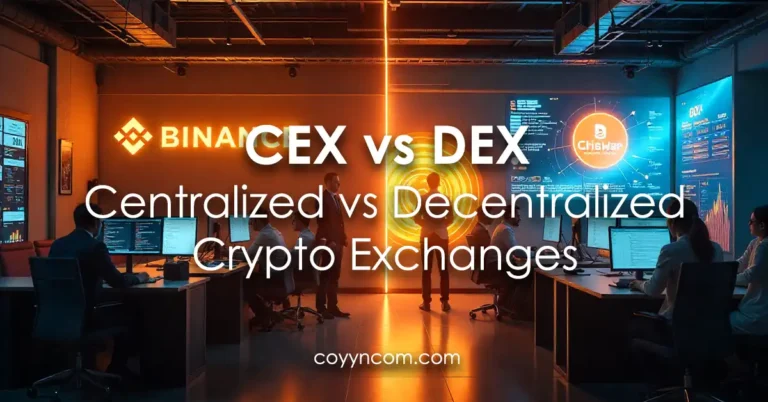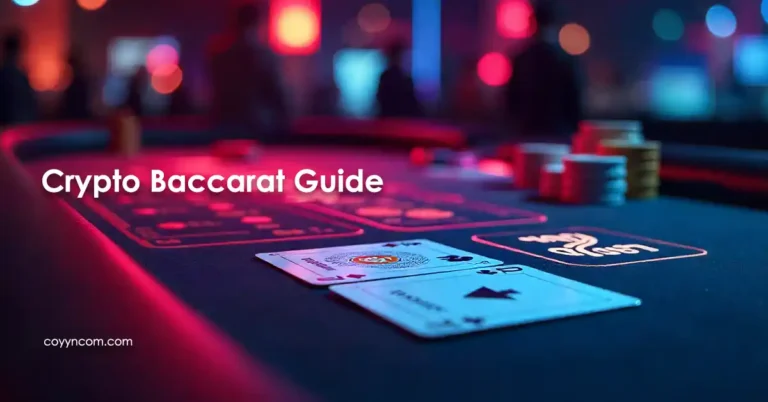Curious about crypto but not sure where to begin? You’re not alone. With terms like blockchain, tokens, and wallets flying around, stepping into the crypto world can feel overwhelming.
The good news? You don’t need to be a tech expert to understand it. Whether you’re looking to invest, explore, or simply keep up with the conversation, learning the basics is easier than you think. This crypto 101 for beginners guide is designed to give you exactly what you need—without the confusion.
Imagine having the confidence to know what Bitcoin is, how exchanges work, or why everyone keeps talking about NFTs. With this step-by-step guide, you’ll get clear, concise answers to the most common questions. We’ve broken down crypto 101 into digestible parts so you can understand the essentials and take control of your learning.
Ready to dive in? Let’s walk through the core concepts of crypto—one simple step at a time. Your journey into digital currency starts right here.
What Is Cryptocurrency?
- Simple Definition: Provide a clear definition of cryptocurrency as a digital or virtual currency that uses cryptographic technology for security. Explain that cryptocurrencies (often just called “crypto”) enable peer-to-peer transactions on the internet without needing banks or governments.
- Key Characteristics: Highlight core features – decentralized (no central bank control), secured by cryptography (nearly impossible to counterfeit or double-spend), and typically recorded on a public ledger (blockchain). Mention that Bitcoin was the first cryptocurrency (launched in 2009) and set the stage for all others.
- Crypto vs. Traditional Money: Briefly compare cryptocurrency to traditional fiat currency. Point out that unlike dollars or euros, crypto isn’t issued or backed by any government, and transactions can happen 24/7 globally without intermediaries. This makes crypto transactions faster in some cases and not subject to the same fees or restrictions as bank transfers.
- Why It’s Trending: Note the growing popularity of crypto in finance and tech. Explain that this crypto 101 for beginners guide will break down what crypto is, why it matters, how it works, and how to get started in simple terms.
Why Crypto Matters
- Financial Freedom & Decentralization: Explain the significance of crypto in giving users more control over their money. Because crypto is decentralized, it allows people to transact directly without relying on banks or payment processors, potentially lowering fees and removing barriers (important for the unbanked population).
- Innovation in Finance: Discuss how cryptocurrency and blockchain technology are transformative innovations. They introduce new possibilities like smart contracts (self-executing agreements) and decentralized finance, which can make financial services more accessible and transparent.
- Investment and Value: Note that crypto has become a new asset class. Early cryptocurrencies like Bitcoin have seen massive growth in value, drawing attention as alternative investments. Mention that some people view Bitcoin as “digital gold” (a hedge against inflation or unstable economies), illustrating why crypto has garnered so much interest.
- Real-World Impact: Provide a couple of real-world examples of why crypto matters – for instance, fast cross-border payments (remittances can be quicker and cheaper with crypto) and the ability to transfer value globally without currency exchange complications. It’s also spurred the development of new industries (like the NFT art market and blockchain gaming), showing its broader impact beyond just money.
How Blockchain Works?
- Blockchain Basics: Introduce blockchain as the underlying technology behind most cryptocurrencies. Explain it as a distributed digital ledger that records transactions in a chain of blocks. Each block contains a batch of transaction records, and once added to the chain, the data is extremely difficult to alter (providing security and trust).
- Decentralized Ledger: Emphasize that the blockchain is maintained by a network of computers (nodes) around the world rather than a central server. Every node has a copy of the ledger, and they must all agree on new transactions – this makes the system decentralized and resistant to single points of failure.
- Transaction Process: Outline in simple terms what happens when a crypto transaction occurs (e.g., Alice sends 1 BTC to Bob) – the transaction is broadcast to the network, verified by participants, and then grouped into a new block. When the block is confirmed, it’s added to the chain, and Bob now owns that Bitcoin.
- Consensus and Security: Briefly explain how transactions are verified through consensus mechanisms. For example, mention Proof of Work (Bitcoin’s method, where “miners” use computing power to solve puzzles and secure the network) versus Proof of Stake (newer method used by some coins like Ethereum, where “validators” stake crypto to secure the network). These mechanisms ensure only legitimate transactions get added to the blockchain.
- Why It’s Trustworthy: Summarize why blockchain technology is so secure – due to cryptographic linking of blocks (each block references the previous one, forming an immutable chain) and the decentralized consensus, no single party can easily cheat the system. This trust without a central authority is a fundamental innovation that makes cryptocurrency possible.
Types of Cryptocurrency
- Overview: Introduce the fact that thousands of cryptocurrencies exist, but they generally fall into a few major categories. Emphasize understanding the different types of cryptocurrency helps beginners grasp the crypto landscape.
Bitcoin (BTC)
- The First Cryptocurrency: Explain that Bitcoin is the original cryptocurrency, created in 2009 by the pseudonymous Satoshi Nakamoto. It introduced the world to blockchain technology and remains the largest cryptocurrency by market capitalization.
- Key Features: Note that Bitcoin is often called “digital gold.” It’s designed to be scarce (capped supply of 21 million BTC) and focuses on being a decentralized digital store of value and peer-to-peer electronic cash.
- Why It’s Important: Mention Bitcoin’s influence – how it paved the way for all other coins and is widely accepted. Many beginners start with Bitcoin because of its longevity and perceived stability relative to other cryptos.
Ethereum (ETH)
- More Than a Currency: Introduce Ethereum as the second-most popular cryptocurrency, but clarify that it’s actually a blockchain platform as well. Launched in 2015, Ethereum’s blockchain supports smart contracts – self-executing programs – enabling a whole ecosystem of decentralized applications (dApps).
- Smart Contracts & Use Cases: Explain in simple terms that Ethereum allows developers to build new crypto applications (like decentralized finance apps, NFT marketplaces, games, etc.) on its network. ETH (Ether) is the native token used to power transactions and run those applications (often referred to as “gas” for fees).
- Why It’s Important: Emphasize Ethereum’s role in expanding crypto’s possibilities beyond just digital money. Many altcoins and tokens are built on Ethereum’s technology (ERC-20 tokens), and it’s a cornerstone of innovations like DeFi (Decentralized Finance). This makes Ethereum a key cryptocurrency to know for beginners.
Altcoins (Other Cryptocurrencies)
- Definition of Altcoin: Define “altcoin” as any cryptocurrency that isn’t Bitcoin. There are thousands of altcoins, each with different features or purposes. Some are forks or variations of Bitcoin’s code, while others are built on separate blockchains or platforms.
- Examples of Altcoins: Give a few notable examples:
- Litecoin (LTC): A Bitcoin spin-off designed for faster transactions (“silver to Bitcoin’s gold”).
- Ripple (XRP): A crypto focused on bank and payment network use cases (fast, low-cost international transfers).
- Cardano (ADA): A blockchain platform similar to Ethereum, emphasizing research-driven development and security.
- Meme Coins (e.g., Dogecoin): Started as internet memes, sometimes gaining huge communities and market value despite having playful origins.
- Litecoin (LTC): A Bitcoin spin-off designed for faster transactions (“silver to Bitcoin’s gold”).
- Stablecoins: Mention stablecoins as a special altcoin category. These are cryptocurrencies pegged to stable assets (like the US dollar) to reduce volatility – for example, Tether (USDT) or USD Coin (USDC) usually aim to stay at $1.00. Stablecoins are often used by beginners to step into crypto because their value is steady, making them useful for trading or saving without the wild price swings.
- Diversity of Purpose: Point out that different altcoins serve different purposes – some are meant to be currencies, others are utility tokens for specific platforms, some grant governance rights in a project, etc. This diversity means beginners should research individual coins’ goals and technology before investing, as not all altcoins are equal in potential or risk.
How to Buy Crypto?
- Getting Started: Explain that buying cryptocurrency as a beginner typically involves using a cryptocurrency exchange or trading platform. Emphasize the importance of choosing a reputable platform that operates in your country and supports the crypto you want to buy.
- Step-by-Step Guide: Provide a clear sequence of steps to demystify the buying process:
- Choose a Platform: Select a trusted cryptocurrency exchange or broker (examples: Coinbase, Binance, Kraken, etc.). Compare factors like fees, user-friendliness, security, and supported coins. Beginners may prefer well-known exchanges with simple interfaces.
- Create an Account: Sign up on the platform by providing required information. Complete any KYC (Know Your Customer) identity verification if required (most regulated exchanges will ask for ID documents). Enable security features like two-factor authentication on the account for safety.
- Deposit Funds: Add money to your account. This could mean linking a bank account or credit card and depositing fiat currency (e.g., USD, EUR), or in some cases, using other payment methods. Some platforms also allow buying crypto directly with a credit card, though fees might be higher.
- Buy Cryptocurrency: Once your fiat funds are available, navigate to the trading section. Select the cryptocurrency you want (e.g., buy Bitcoin). Enter the amount you wish to purchase – you can often buy fractional amounts (you don’t need to buy a whole Bitcoin). Review the transaction details (amount of crypto, price, fees) and confirm the purchase. The platform will execute the order and the crypto will appear in your account’s wallet on the exchange.
- Secure Your Crypto: After buying, consider transferring your cryptocurrency to a personal crypto wallet for better security (see next section on wallets). Keeping funds on an exchange can be convenient for trading, but it’s riskier long-term due to hacking risks. If you plan to hold for a while, moving coins to your own wallet (where you control the private keys) is a recommended practice for safety.
- Choose a Platform: Select a trusted cryptocurrency exchange or broker (examples: Coinbase, Binance, Kraken, etc.). Compare factors like fees, user-friendliness, security, and supported coins. Beginners may prefer well-known exchanges with simple interfaces.
- Alternative Buying Methods: (Optional bullet) Mention that besides exchanges, beginners have other options like Bitcoin ATMs, peer-to-peer marketplaces, or financial apps (PayPal, Cash App) that offer crypto. However, using a major exchange is generally the easiest and most straightforward way to buy crypto for the first time.
What Is a Crypto Wallet?
- Wallet Definition: Define a crypto wallet as a secure digital wallet used to store, send, and receive cryptocurrencies. Clarify that a wallet doesn’t actually hold coins in a physical sense; rather, it stores the private keys that give you access to your coins on the blockchain. In essence, if you own the keys, you control the crypto associated with those keys.
- Importance of Wallets: Explain why wallets are essential. To interact with cryptocurrencies (beyond just keeping them on an exchange), you need a wallet address. Wallets allow you to manage your crypto assets – they provide addresses for receiving funds and interfaces for sending funds. Also emphasize security: using the right kind of wallet can protect your crypto from online threats. Introduce the phrase “not your keys, not your coins,” meaning if you don’t hold the private keys (as is the case on a custodial exchange wallet), you don’t truly control the crypto. This underscores the value of personal wallets for long-term holding.
Types of Crypto Wallets
- Hot vs. Cold Wallets: Explain the two broad categories of wallets:
- Hot Wallets (Online): Wallets that are connected to the internet. These include mobile wallets (apps on your phone), desktop wallets (software on your computer), and web wallets (accessed via browser). They are user-friendly and convenient for frequent access or trading. However, being online means they are more vulnerable to hacking or malware attacks. Examples: Coinbase Wallet app, MetaMask (browser wallet), or even the default wallet on an exchange (exchange wallets are custodial hot wallets).
- Cold Wallets (Offline): Wallets that remain offline, offering high security. These include hardware wallets (physical devices like a USB stick – e.g., Ledger or Trezor) and paper wallets (literally printing your keys/QR codes on paper and storing it safely). Cold storage keeps your private keys off the internet, drastically reducing the risk of hacks. They are ideal for long-term storage of significant amounts. The trade-off is a bit less convenience for day-to-day transactions.
- Hot Wallets (Online): Wallets that are connected to the internet. These include mobile wallets (apps on your phone), desktop wallets (software on your computer), and web wallets (accessed via browser). They are user-friendly and convenient for frequent access or trading. However, being online means they are more vulnerable to hacking or malware attacks. Examples: Coinbase Wallet app, MetaMask (browser wallet), or even the default wallet on an exchange (exchange wallets are custodial hot wallets).
- Custodial vs. Non-Custodial: Define the difference in terms of who controls the private keys:
- Custodial Wallet: A third party (like an exchange) holds the private keys for you. This is easier for beginners since you don’t have to manage keys or backups – if you forget your password, the service can help recover access. However, you are trusting that service to keep your crypto safe. If the service is hacked or becomes insolvent, your funds could be at risk.
- Non-Custodial Wallet: You control the private keys. This can be a hot or cold wallet (for example, a mobile app wallet where you receive a recovery seed phrase is non-custodial, as is a hardware wallet). Non-custodial means full ownership of your crypto – but it also means full responsibility. Stress that beginners should safely back up their wallet’s seed phrase or private key. If lost, access to the crypto is gone permanently (no “forgot password” option in a truly decentralized wallet).
- Custodial Wallet: A third party (like an exchange) holds the private keys for you. This is easier for beginners since you don’t have to manage keys or backups – if you forget your password, the service can help recover access. However, you are trusting that service to keep your crypto safe. If the service is hacked or becomes insolvent, your funds could be at risk.
- Choosing a Wallet: Give guidance that beginners might start with a simple hot wallet for small amounts (since it’s easy to use) but should consider a hardware wallet if they accumulate larger value. Remind them that no matter the wallet type, they must guard their keys/seed phrases carefully (keep them offline and private) to prevent theft.
Cryptocurrency Exchanges: Centralized vs. Decentralized
- What Are Crypto Exchanges: Introduce cryptocurrency exchanges as platforms where people can buy, sell, or trade crypto. There are two main models – centralized exchanges (CEX) and decentralized exchanges (DEX) – each with its own approach and user experience. Explain that as a beginner, you will likely encounter both, but they operate differently.
Centralized Exchanges (CEX)
- How CEXs Work: Explain that centralized exchanges are run by companies (a central authority) and act as middlemen for crypto trades. Users deposit their money (fiat or crypto) into the exchange and the exchange facilitates trades between buyers and sellers using its internal systems.
- Features of CEXs: Note that CEXs (like Coinbase, Binance, Kraken) are popular because they are user-friendly, typically offering easy interfaces, customer support, and additional features like mobile apps. They often allow direct purchases of crypto with fiat, which is convenient for beginners.
- Pros: List benefits – high liquidity (easy to find buyers/sellers, so trades execute quickly at market prices), and a wide selection of trading pairs. They may offer other services like crypto staking, lending, or advanced trading tools, but those are optional.
- Cons: Mention downsides – users must trust the exchange to hold their funds (it’s a custodial platform), and thus one’s crypto is vulnerable if the exchange is hacked or mismanages funds. Also, centralized exchanges usually require registration and personal identification (KYC), so they are less private. Furthermore, they can be subject to regulations or even outages under heavy usage. For beginners, however, the ease of use often outweighs these issues initially, as long as they stick to reputable exchanges.
Decentralized Exchanges (DEX)
- How DEXs Work: Explain that decentralized exchanges operate without a central authority. Instead, they use smart contracts on a blockchain (for example, many DEXs run on Ethereum or other smart-contract platforms) to enable users to trade directly from their own wallets. There is no central company holding funds – trades happen peer-to-peer via the blockchain network.
- Features of DEXs: On a DEX (like Uniswap, SushiSwap, or PancakeSwap), users retain control of their crypto; you connect your personal wallet to the DEX interface and swap tokens directly. Emphasize no custody – you never deposit funds into the DEX, which means if you execute a trade, the tokens go straight to your wallet.
- Pros: DEXs offer greater privacy and control. Typically, there’s no account creation or KYC – anyone with a supported wallet can trade. They also provide access to a huge variety of tokens, including new or niche projects that may not be listed on CEXs. Censorship-resistance is another benefit; because they run on decentralized infrastructure, there’s no single entity that can easily restrict trading of certain assets.
- Cons: Note the challenges – DEXs can be less intuitive for newcomers. The interfaces might be confusing, transactions often require paying network fees (gas fees on Ethereum, for instance), and trades aren’t instantaneous in the same way (they settle on-chain, which can take some time depending on the network). Also, liquidity can be lower for certain tokens, meaning large trades might impact the price. Importantly, using DEXs requires caution: there’s risk of interacting with fraudulent tokens or smart contract bugs, and if you make a mistake (send funds to the wrong address, etc.), there’s no support team to help.
- When to Use: Summarize that beginners might not need to use DEXs right away unless they are looking for a coin not on major exchanges or want to dive into DeFi. It’s good to be aware of them as part of the crypto ecosystem. Over time, as one becomes more comfortable with wallets and blockchain transactions, DEXs can be a powerful tool for truly decentralized trading.
Risks of Crypto Investing
- No Guarantees: Start with a caution that while crypto offers exciting opportunities, it also comes with significant risks. Beginners should be aware of these crypto investing risks before putting money in.
Volatility and Market Swings
- Extreme Price Fluctuations: Explain that cryptocurrency prices are highly volatile. It’s common to see double-digit percentage price changes in a single day. For example, Bitcoin might drop or surge in value very quickly based on market sentiment, news, or even social media trends.
- Emotional Rollercoaster: Emphasize the emotional challenge – new investors might panic sell during a crash or get overly greedy during a surge. Volatility means potential for high returns but also significant losses. Suggest that beginners be mentally prepared for dramatic ups and downs and avoid making impulsive decisions due to short-term market movements.
- Lack of Historical Stability: Unlike blue-chip stocks or government bonds, cryptocurrencies (even Bitcoin) have a relatively short history and can’t guarantee long-term stability. Prices are driven by speculation and supply-demand, which can be unpredictable. This inherent volatility is perhaps the most obvious risk of crypto investing.
Security Risks and Scams
- Hacking and Theft: Discuss the security threats in the crypto space. If an exchange gets hacked (which has happened on some platforms in the past), user funds can be stolen. If a hacker compromises your personal wallet (e.g., through malware on your computer or by obtaining your private key), your crypto can be taken with little recourse – transactions are irreversible.
- User Error: Highlight that there’s also risk in user mistakes: sending crypto to the wrong address (those funds may be lost forever), or losing your wallet’s private key/seed phrase (which means losing access to your crypto permanently). There’s no bank to call for recovering a lost password to a non-custodial wallet.
- Scams and Fraud: Warn about the prevalence of scams targeting crypto newbies – phishing emails or messages that try to steal login credentials or keys, fake investment schemes promising guaranteed returns, “rug pull” projects where creators vanish with investors’ money, and impersonation scams (someone pretending to be tech support or a friend asking for crypto). Advise beginners to be extremely skeptical of any scheme that sounds too good to be true, and to double-check URLs and identities when dealing in crypto.
- No Insurance or Protection: Note that unlike money in a bank (which might have deposit insurance) or fraudulent credit card charges (which you can dispute), crypto transactions typically have no insurance and very limited legal protections. Once funds leave your wallet, it’s usually final. This means personal vigilance is crucial.
Regulatory and Legal Risks
- Changing Regulations: Explain that the regulatory environment for cryptocurrency is still evolving worldwide. Governments differ in how they treat crypto – some embrace it, others impose strict regulations or even bans. There’s a risk that new laws could affect the value of crypto or one’s ability to use it. For instance, if a country suddenly bans crypto trading or imposes heavy taxes, it can impact investors significantly.
- Lack of Consumer Protection: Because crypto is relatively new and not uniformly regulated, investors don’t always have the same protections they might have in traditional finance. For example, there’s no guaranteed recovery if an exchange shuts down or if you fall victim to fraud. Legal recourse can be limited and depends on jurisdiction.
- Tax Implications: Mention that trading or selling crypto often has tax consequences that beginners might not be aware of. Profits may be subject to capital gains taxes, and the rules can be complex. Not understanding or complying with these rules can be a financial risk (in terms of potential penalties). Encourage readers to educate themselves on their local regulations and to use crypto within the law.
Tips for Crypto Beginners
- Start Small and Only Invest What You Can Afford to Lose: Cryptocurrency is high-risk. As a beginner, begin with a small investment amount. This way, if the market swings or you make a mistake, it won’t financially devastate you. Consider any money put into crypto as venture capital – there’s potential for growth but you must be okay with the possibility of loss.
- Do Your Own Research (DYOR): Always research any coin or project before investing. Don’t just rely on hype from social media or tips from friends. Read up on what a project does, who is behind it, and its community. Understanding the fundamentals will help you make informed decisions and avoid scams. If something is unclear or seems sketchy, hold off. In crypto, knowledge is power, so continue learning (through reputable articles, tutorials, forums) as you go.
- Diversify Your Holdings: It’s generally unwise to put all your funds into a single cryptocurrency. Diversification can mitigate risk – for example, holding a mix of Bitcoin, maybe some Ethereum, and a few other well-established altcoins can balance out volatility (when one goes down, another might be up). That said, don’t over-diversify into too many obscure coins either – stick to projects you’ve researched and believe in.
- Use Reputable Platforms: Whether choosing an exchange to buy crypto or a wallet to store it, opt for well-known and trusted services. Big exchanges with a good track record and robust security measures are safer for beginners. When downloading wallet apps or other crypto software, double-check that you’re getting the official version (there are fake apps out there). Trust is critical in this space – if in doubt, seek reviews or beginner community recommendations.
- Prioritize Security: Take security seriously from day one. Use strong, unique passwords for your crypto accounts and enable two-factor authentication (2FA) wherever possible. Never share your wallet’s seed phrase or private keys with anyone. Be cautious of phishing attempts – for instance, always verify you’re on the correct website (scammers often create look-alike exchange sites). It’s also wise to keep your devices secure and updated (to avoid malware). For significant crypto holdings, consider using a hardware wallet to keep your assets safe offline.
- Avoid Emotional Trading: It’s easy to get caught up in the excitement or fear of market swings – a common saying is “Don’t FOMO and don’t panic sell.” FOMO (Fear Of Missing Out) might push you to buy when prices are very high because everyone is talking about a coin, which can lead to losses if the price corrects. Conversely, a sudden drop might tempt you to panic sell at a low, locking in losses. Instead, try to keep a long-term perspective: if you’ve done your research and believe in the project, hold through the turbulence. Having a plan (e.g., only investing for the long term or setting aside an amount you’re willing to trade) can help manage emotions.
- Stay Informed and Continuous Learning: The crypto world evolves quickly. New developments, updates (like blockchain upgrades), and market news can impact your investments. Follow reliable news sources or communities for updates. Additionally, expand your knowledge – once you grasp the basics, you might explore related topics (for example, how decentralized finance works or what NFTs are) to round out your understanding. An informed investor is a more confident and usually more successful investor.
Common Crypto Terms Explained
Cryptocurrency discussions are filled with jargon and acronyms. Here’s a quick glossary of popular crypto terms every beginner should know:
- Blockchain: A decentralized digital ledger that records transactions across many computers. It’s the technology that underpins cryptocurrencies, ensuring transparency and security by linking blocks of data in an immutable chain (see How Blockchain Works above for details).
- Decentralization: The principle of distributing power away from a central authority. In crypto, this means no single entity (like a bank or government) controls the network – control is spread across participants. Decentralization enhances security and trust, as the network isn’t reliant on any one point of failure.
- Altcoin: Short for “alternative coin,” this refers to any cryptocurrency that isn’t Bitcoin. Altcoins range from well-known ones like Ether (Ethereum’s coin) to thousands of smaller projects. Usage example: “Ethereum is the largest altcoin by market cap.”
- Stablecoin: A type of cryptocurrency designed to maintain a stable value by being pegged to an asset like the US dollar or gold. For example, 1 USDT (Tether) aims to always be worth $1. Stablecoins are useful for traders to park funds without exiting the crypto ecosystem and for making transactions without worrying about price swings.
- Fiat: Traditional government-issued currency, like USD, EUR, or JPY. You’ll often hear “fiat money” in crypto discussions to differentiate from crypto assets. For instance, buying crypto typically involves converting fiat (such as dollars) into cryptocurrency.
- Wallet (Crypto Wallet): A secure digital wallet used to store, send, and receive cryptocurrency. It stores your private keys and public addresses. Think of it as your crypto bank account, except you are the bank. (See What Is a Crypto Wallet? above for more.)
- Private Key: A secret alphanumeric password that allows you to access and manage your cryptocurrency in a wallet. Do not share this. Whoever has the private key can control the coins. It’s like the PIN to your bank account, but even more powerful – if lost or stolen, your funds are likely gone for good.
- Public Key / Address: The public-facing counterpart to the private key. A public address (often a shorter form of the public key) is like your crypto email address – you can share it with others to receive funds. Example: a Bitcoin address looks like a long string of characters (e.g., 1BoatSLRHtKNngkdXEeobR76b53LETtpyT). People use that to send you Bitcoin, and only the private key linked to it can unlock and send those funds away.
- Smart Contract: A self-executing contract with the terms directly written into code on the blockchain. Smart contracts automatically enforce and execute agreements when predefined conditions are met, without needing intermediaries. Ethereum made this concept popular. Example use: a smart contract could automatically send payment when a task is completed, based on its code.
- HODL: A slang term in the crypto community meaning “hold” (originating from a typo hold->hodl in a forum, now backronymed to “Hold On for Dear Life”). It represents a long-term approach to crypto – ignoring short-term market volatility and resisting the urge to sell during dips. If someone says “I’m going to hodl my Bitcoin,” it means they plan to keep holding despite any price fluctuations.
- FOMO: Acronym for “Fear Of Missing Out.” In crypto, this refers to the anxiety that you might miss a big opportunity – often what people feel when they see a coin’s price skyrocketing and are tempted to buy in at the peak. It’s generally advised to avoid making decisions based on FOMO; stick to your research and strategy.
Conclusion
- Recap the Journey: Conclude by summarizing that cryptocurrency is an exciting new form of money and technology that anyone can learn. Reiterate how we covered the basics – from what crypto is and how blockchain works to practical aspects like buying crypto, using wallets, understanding exchanges, and staying aware of risks. This solid foundation should empower beginners to explore the crypto world more confidently.
- Balanced Perspective: Encourage readers to approach crypto with a balanced mindset: acknowledge the innovative potential and opportunities (financial inclusion, investment growth, technological innovation) while also respecting the risks involved. Remind them that volatility and uncertainty don’t mean crypto is “bad,” but rather that caution and due diligence are required.
- Next Steps: Suggest practical next steps for the reader. For instance, they might start by opening an account on a reputable exchange and making a small test purchase, or setting up their first crypto wallet and trying a transfer with a tiny amount to get familiar. Encourage them to apply the tips for crypto beginners covered above, like doing thorough research and prioritizing security.
- Stay Curious and Informed: End on a positive note that the crypto space is continuously evolving. By staying curious, continuously learning, and engaging with the community, beginners can gradually deepen their understanding. Crypto can seem complex at first, but with time and experience, terms will become clearer and the process more second-nature. Invite them to keep exploring – today’s “Crypto 101” knowledge is just the beginning of a fascinating journey into the world of cryptocurrency.
Frequently Asked Question Answers
-
What is cryptocurrency and how does it work?
Cryptocurrency is a digital form of money secured by cryptography and powered by blockchain technology. It allows peer-to-peer transactions without banks.
-
How do I buy cryptocurrency as a beginner?
To buy crypto, sign up on a trusted exchange, verify your identity, deposit fiat money, and purchase your chosen coin. Always enable security features.
-
What’s the difference between Bitcoin and Ethereum?
Bitcoin is a digital store of value, often called “digital gold.” Ethereum is a platform for building decentralized apps and supports smart contracts.
-
Do I need a crypto wallet to store my coins?
Yes. A crypto wallet stores your private keys and helps manage your assets. Beginners can use hot wallets; hardware wallets offer more security.
-
Are cryptocurrencies safe to invest in?
Crypto is high-risk and volatile. While secure with proper use, it lacks regulation and insurance. Only invest what you can afford to lose.
-
What’s the safest way to start with crypto?
Start small, use reputable exchanges, enable 2FA, and transfer assets to a secure wallet. Learn the basics before investing more.
-
Can I lose my crypto if I forget my wallet password?
If you lose your wallet’s private key or seed phrase, you may permanently lose access to your crypto. Always back it up in a secure place.






